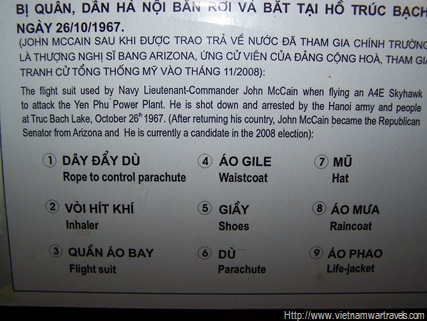The flight suit of Senator and future presidential candidate John McCain is on display at the Hanoi Hilton (Hoa Loa Prison) while trusty Wikipedia has a good account of what happened on his ill fated flight and when he arrived as a POW:
On October 26, 1967, McCain was flying his twenty-third mission, part of a twenty-plane strike force against the Yen Phu thermal power plant in central Hanoi that previously had almost always been off-limits to U.S. raids due to the possibility of collateral damage. Arriving just before noon, McCain dove from 9,000 to 4,000 feet on his approach; as he neared the target, warning systems in McCain’s A-4E Skyhawk alerted him that he was being tracked by enemy fire-control radar. Like other U.S. pilots, he would not consider breaking off a bombing run, and he held his dive until he released his bombs at about 3,500 feet (1,000 m). As he started to pull up, the Skyhawk’s wing was blown off by a Soviet-made SA-2 anti-aircraft missile fired by the North Vietnamese Air Defense Command’s 61st Battalion, commanded by Captain Nguyen Lan and with fire control officer Lieutenant Nguyen Xuan Dai. (McCain was later awarded the Distinguished Flying Cross for this day, while Nguyen Xuan Dai was awarded the title Hero of the People’s Armed Forces. Decades later, Soviet Army Lieutenant Yuri Trushechkin claimed that he had been the missile guidance officer who had shot McCain down. In any case, the raid was a failure, as the power plant was not damaged and three of the Navy planes were shot down.)
McCain’s plane went into a vertical inverted spin. Bailing out upside down at high speed,the force of the ejection fractured McCain’s right arm in three places, his left arm, and his right leg at the knee, and knocked him unconscious. McCain nearly drowned after parachuting into Trúc Bạch Lake in Hanoi; the weight of his equipment was pulling him down, and as he regained consciousness, he could not use his arms. Eventually, he was able to inflate his life vest using his teeth. Several Vietnamese, possibly led by Department of Industry clerk Mai Van On, pulled him ashore. A mob gathered around, spat on him, kicked him, and stripped him of his clothes; his left shoulder was crushed with the butt of a rifle and he was bayoneted in his left foot and abdominal area. He was then transported to Hanoi’s main Hoa Lo Prison, nicknamed the “Hanoi Hilton” by American POWs.
McCain reached Hoa Lo in as bad a physical condition as any prisoner during the war. His captors refused to give him medical care unless he gave them military information; they beat and interrogated him, but McCain only offered his name, rank, serial number, and date of birth (the only information he was required to provide under the Geneva Conventions and permitted to give under the U.S. Code of Conduct). Soon thinking he was near death, McCain said he would give them more information if taken to the hospital, hoping he could then put his interrogators off once he was treated. A prison doctor came and said it was too late, as McCain was about to die anyway. Only when the North Vietnamese discovered that his father was a top admiral did they give him medical care, calling him “the crown prince”. Two days after McCain’s plane went down, that event and his status as a POW made the front pages of The New York Times and The Washington Post. Interrogation and beatings resumed in the hospital; McCain gave the North Vietnamese his ship’s name, squadron’s name, and the attack’s intended target. This information, along with personal details of McCain’s life and purported statements by McCain about the war’s progress, would appear over the next two weeks in the North Vietnamese official newspaper Nhân Dân as well as in dispatches from outlets such as the Cuban news agency Prensa Latina. Disclosing the military information was in violation of the Code of Conduct, which McCain later wrote he regretted, although he saw the information as being of no practical use to the North Vietnamese. Further coerced to give future targets, he named cities that had already been bombed, and responding to demands for the names of his squadron’s members, he supplied instead the names of the Green Bay Packers’ offensive line.
McCain spent six weeks in the hospital, receiving marginal care in a dirty, wet environment. A prolonged attempt to set the fractures on his right arm, done without anesthetic, was unsuccessful; he received an operation on his broken leg but no treatment for his broken left arm. He was temporarily taken to a clean room and interviewed by a French journalist, François Chalais, whose report was carried on the French television program Panorama in January 1968 and later in the U.S. on the CBS Evening News. The film footage of McCain lying in the bed, in a cast, smoking cigarettes and speaking haltingly,would become the most well-known images of McCain’s imprisonment. McCain was observed by a variety of North Vietnamese, including renowned Vietnamese writer Nguyễn Tuân and Defense Minister and Army commander-in-chief General Vo Nguyen Giap. Many of the North Vietnamese observers assumed that McCain must be part of America’s political-military-economic elite. Now having lost fifty pounds (twenty-three kilograms), in a chest cast, covered in grime and eyes full of fever, and with his hair turned white, in early December 1967 McCain was sent to a prisoner-of-war camp on the outskirts of Hanoi nicknamed “the Plantation”. He was placed in a cell with George “Bud” Day, a badly injured and tortured Air Force pilot (later awarded the Medal of Honor) and Norris Overly, another Air Force pilot; they did not expect McCain to live another week. Overly, and subsequently Day, nursed McCain and kept him alive; Day later remembered that McCain had “a fantastic will to live”.

